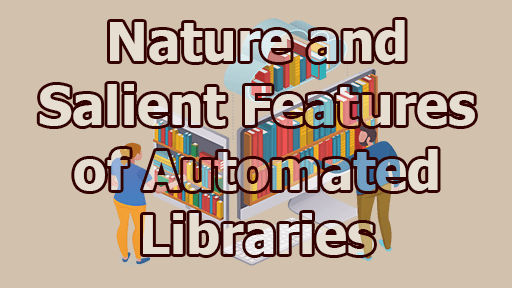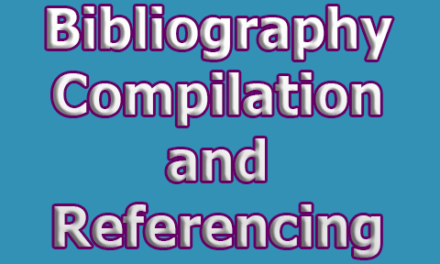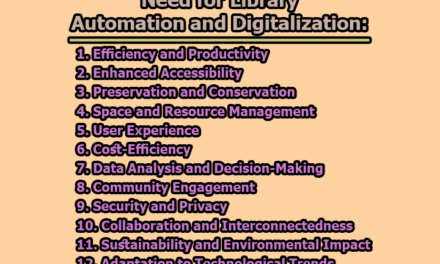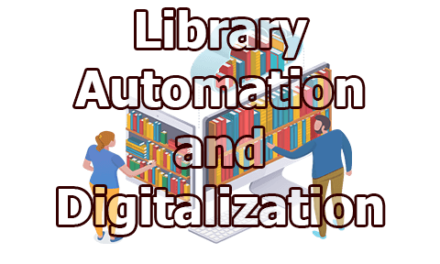Nature and Salient Features of Automated Libraries:
Automated libraries, often referred to as digital libraries or electronic libraries, have revolutionized the way information is stored, accessed, and managed. These libraries leverage technology to offer a wide range of services and resources to users, making the process of information retrieval and dissemination more efficient and convenient. Here are the nature and salient features of automated libraries:
Nature of Automated Libraries:
1. Digital Content: Automated libraries host a vast array of digital content that encompasses various formats, including:
- E-books: These libraries offer an extensive collection of electronic books spanning multiple genres and subjects. E-books are convenient for readers as they can be accessed on e-readers, tablets, or computers.
- E-journals: Users have access to numerous electronic journals, providing the latest research findings, academic articles, and scholarly papers.
- Articles: Alongside e-journals, automated libraries often archive individual articles, enabling users to access specific research papers, magazine articles, and news pieces.
- Multimedia Resources: In addition to textual content, automated libraries offer multimedia resources such as videos, audio recordings, podcasts, webinars, and interactive simulations. These resources cater to different learning styles and preferences.
- Archival Materials: Some automated libraries preserve historical and archival materials, making rare documents, manuscripts, photographs, and recordings accessible to researchers and historians.
2. Accessibility: Automated libraries prioritize accessibility. Users can connect to the library’s digital collection from virtually anywhere with an internet connection. This inclusive approach breaks down geographical barriers, allowing users worldwide to tap into the wealth of knowledge and resources offered.
3. Search and Retrieval: Automated libraries employ sophisticated search mechanisms, including advanced search algorithms and metadata tagging. These tools ensure efficient and accurate information retrieval.
Users can initiate searches using various parameters such as keywords, author names, titles, publication dates, and subject categories. This granular search capability streamlines the process of finding precisely what they need.
4. 24/7 Availability: Automated libraries break away from the constraints of traditional library hours. They are open around the clock, every day of the year. Users are not bound by fixed schedules and can access resources at any time, accommodating various time zones and individual schedules.
5. Multimedia Resources: The inclusion of multimedia content enriches the learning experience and supports diverse learning styles. Users can watch educational videos, listen to audio lectures, or engage with interactive simulations, enhancing comprehension and engagement with the material.
6. Interactivity: Some automated libraries go beyond static content by incorporating interactive features. These may include:
- Annotation Tools: Users can highlight, annotate, and take notes directly within digital texts, fostering active reading and research practices.
- Discussion Forums: Virtual spaces for users to engage in discussions, share insights, and exchange ideas with peers and experts.
- Collaborative Spaces: Shared workspaces that facilitate group projects, research collaboration, and knowledge sharing.
7. Remote Learning Support: Automated libraries have become invaluable tools for distance learning and online education. They provide an extensive repository of educational materials, research resources, and reference materials that support remote learners, educators, and researchers worldwide.
These libraries offer a seamless transition to digital learning environments, ensuring that educational resources are accessible and adaptable to diverse learning needs and modes.
Salient Features of Automated Libraries:
1. Digital Collections: Automated libraries boast extensive digital collections that transcend the limitations of physical libraries. They can house a vast number of e-books, e-journals, multimedia resources, and archival materials. These digital collections often exceed the capacity of traditional libraries, providing a virtually unlimited repository of knowledge.
2. Metadata and Cataloging: Comprehensive metadata and cataloging systems are the backbone of automated libraries. These systems involve:
- Metadata Tagging: Each digital resource is meticulously tagged with metadata, including information about the author, title, publication date, subject, keywords, and more. This metadata ensures that resources are properly organized and can be easily discovered through searches.
- Thematic Catalogs: Automated libraries create thematic catalogs that categorize resources into subject-specific collections, making it easier for users to locate materials related to their research interests.
3. Authentication and Access Control: To protect copyrighted materials and sensitive information, automated libraries employ robust authentication and access control mechanisms. These mechanisms verify the identity of users and grant access only to authorized individuals, ensuring that intellectual property rights are respected.
4. Cross-Search Capabilities: Many automated libraries offer federated search capabilities, enabling users to simultaneously search across multiple databases and collections. This feature provides users with a holistic view of available resources, streamlining the research process and saving time.
5. Personalization: Users often have the option to create accounts and personalize their library experience. This includes:
- Saved Searches: Users can save their search queries for future reference, making it convenient to revisit specific topics or research interests.
- Preferences: Users can set preferences related to search results, display options, and notification settings.
- Alerts: Automated libraries may offer alert services that notify users of new content relevant to their interests, ensuring they stay updated on the latest research and publications.
6. Preservation: Automated libraries prioritize the preservation of digital assets to prevent degradation, loss, or obsolescence. Preservation strategies may involve:
- Backup Systems: Regular backups are performed to protect against data loss due to technical failures or cyber threats.
- Format Migration: Digital assets are periodically migrated to newer file formats to ensure they remain accessible as technology evolves.
- Redundant Storage: Multiple copies of digital resources may be stored in geographically dispersed locations to safeguard against catastrophic events.
7. Remote Access: Remote access is a fundamental feature of automated libraries, allowing users to connect and access resources from various devices, including computers, tablets, and smartphones. This flexibility ensures that users can engage with library materials from virtually anywhere.
8. Open Access: Some automated libraries align with open access principles by providing free access to a portion of their digital collections. This commitment to open access enhances the availability of knowledge and promotes broader dissemination of scholarly and educational content.
9. Resource Linking: Automated libraries simplify the process of linking and citing digital resources. They often provide persistent identifiers, such as DOIs (Digital Object Identifiers), that facilitate accurate referencing in academic and research work. Users can easily create citations and reference links to share resources.
10. Analytics and Usage Statistics: Automated libraries employ analytics tools to track resource usage and user behavior. This data helps librarians and administrators make informed decisions about optimizing collections and services based on user preferences, needs, and trends.
11. Collaboration and Sharing: Automated libraries frequently support collaborative research and knowledge sharing by offering features such as document sharing, online collaboration tools, and integration with social networking platforms. These tools enhance cooperation among researchers and learners.
12. Scalability: Automated libraries are designed with scalability in mind. They can expand their collections and services to accommodate the growing demands of users and adapt to technological advancements seamlessly. This scalability ensures that libraries remain relevant in an ever-changing information landscape.
In conclusion, automated libraries have transformed the way information is managed and accessed in the digital age. They offer a wide array of resources, robust search capabilities, and convenient access options, making them indispensable tools for researchers, students, professionals, and the general public in their pursuit of knowledge and information.
References:
- Borgman, C. L. (2000). From Gutenberg to the global information infrastructure: Access to information in the networked world. The MIT Press.
- Chowdhury, G. (2003). Introduction to digital libraries. Facet Publishing.
- Chowdhury, G. G., & Chowdhury, S. (2007). Organizing information: From the shelf to the web. Facet Publishing.
- Marchionini, G. (1995). Information seeking in electronic environments. Cambridge University Press.
- Arms, W. Y. (2000). Digital libraries. MIT Press.
- Dempsey, L. (2008). Always already digital: On the threshold with digital collections and services. Journal of Library Administration, 48(2), 217-227.
- Gorman, M. (2000). The digital library. American Libraries, 31(10), 50-52.
- Liew, C. L., Kaur, K., & Foo, S. (2008). Information retrieval and knowledge discovery utilizing a digital library. Online Information Review, 32(4), 495-511.
- Lynch, C. (2005). Institutional repositories: Essential infrastructure for scholarship in the digital age. ARL Bimonthly Report, 226, 1-7.

Library Lecturer at Nurul Amin Degree College










